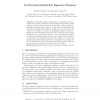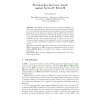107
Voted
CTRSA
2010
Springer
15 years 4 months ago
2010
Springer
This paper presents a new identity based key agreement protocol. In id-based cryptography (introduced by Adi Shamir in [33]) each party uses its own identity as public key and rece...
CTRSA
2010
Springer
15 years 4 months ago
2010
Springer
CTRSA
2010
Springer
15 years 4 months ago
2010
Springer
This paper proposes a new type of cache-collision timing attacks on software implementations of AES. Our major technique is of differential nature and is based on the internal cryp...
124
Voted
CTRSA
2010
Springer
15 years 5 months ago
2010
Springer
A Hierarchical Identity Based Encryption (HIBE) system is anonymous if the ciphertext reveals no information about the recipient’s identity. create it. While there are multiple c...
104
click to vote
CTRSA
2010
Springer
15 years 7 months ago
2010
Springer
Sanitizable signature schemes allow a semi-trusted entity to modify some specific portions of a signed message while keeping a valid signature of the original off-line signer. In...
CTRSA
2010
Springer
15 years 7 months ago
2010
Springer
Security devices are vulnerable to side-channel attacks that perform statistical analysis on data leaked from cryptographic computations. Higher-order (HO) attacks are a powerful a...
119
click to vote
CTRSA
2010
Springer
15 years 7 months ago
2010
Springer
Fairly exchanging digital content is an everyday problem. It has been shown that fair exchange cannot be done without a trusted third party (called the Arbiter). Yet, even with a ...
151
Voted
CTRSA
2010
Springer
15 years 7 months ago
2010
Springer
Abstract. The SHA-3 competition has been organized by NIST to select a new hashing standard. Edon-R was one of the fastest candidates in the first round of the competition. In thi...
114
Voted
CTRSA
2010
Springer
15 years 7 months ago
2010
Springer
Typical security models used for proving security of deployed cryptographic primitives do not allow adversaries to rewind or reset honest parties to an earlier state. Thus, it is c...
107
click to vote
CTRSA
2010
Springer
15 years 7 months ago
2010
Springer
At ches 2009, Coron, Joux, Kizhvatov, Naccache and Paillier (cjknp) exhibited a fault attack against rsa signatures with partially known messages. This attack allows factoring the ...




